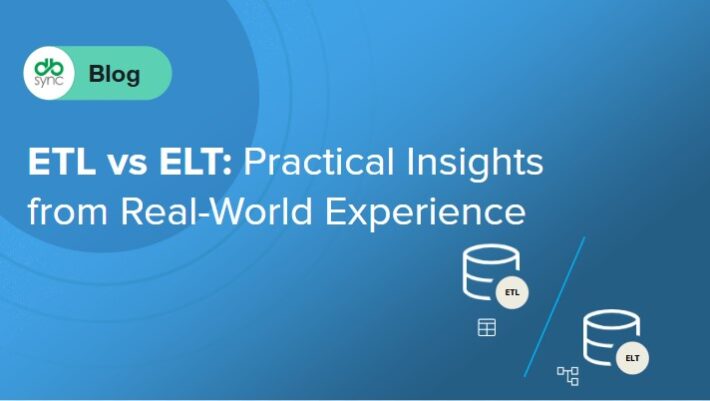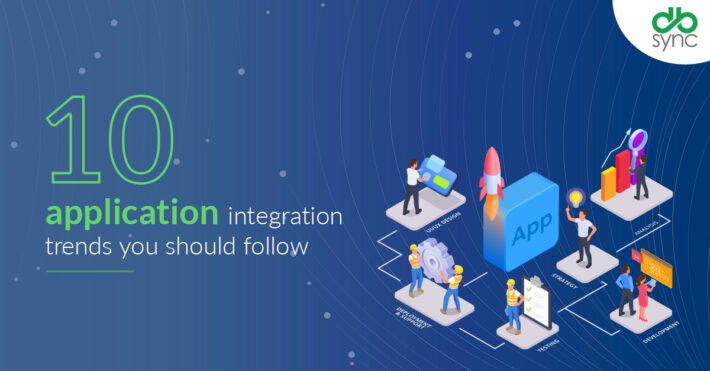Be ahead of the pack with iPaaS, the successor of ETL
Are you on the prowl for the newest thing in software integration? At DBSync, our approach is to bring you the best information on integration available, and we are now about to push the edge of the envelope once more.
This article is a gentle introduction to iPaaS. In it, we will show you what iPaaS is all about, its benefits, techniques and uses. This is going to put you ahead of the pack, adding valuable concepts to your skill set, and help you create an integration strategy that will put your business on the path to success.
And while reading, relax and learn, as this article is aimed at the less-technical “citizen integrators” and at the curious techies alike.
The iPaaS solution
Prior to the emergence of cloud computing, integration was regarded as either internal or business to business (B2B). The technologies behind these were based on the Extract, Transform and Load (ETL) concept.
The advent of SaaS applications created a new kind of demand, which was met through cloud-based integration. The tremendous success of Salesforce was a key factor for businesses to start considering the integration of cloud-based apps and on-premise apps. Businesses wanted to integrate diverse apps such as Gmail or Quickbooks to Salesforce, and create synergies among them. This was the birth of iPaaS.
iPaaS stands for Integration Platform As A Service. As its name indicates, it is simply that, a means of data integration with the following aspects:
- It is cloud-based,
- It can extract data from many different sources,
- It allows for the transformation the data into more meaningful information
- It loads the transformed data into target systems.
The 3 “A”s of iPaaS
The main characteristics of iPaaS can be summarized in the 3 “A”s:
- Anything: iPaaS aims at integrating not only data, but also apps, APIs, and things, thus creating a seamless flow of information that increases efficiency and cost reduction in decision making.
- Anytime: iPaaS considers all your needs, such as real-time information, batch processing, and streaming. The idea behind this is to automate integration processes and optimize the conversion of raw data into information.
- Anywhere: iPaaS is a child of the internet. As a result, it aims at integrating your cloud-based apps together with your on-premises systems. In this way, it creates a unified landscape, from where you can make informed decisions.
The main reasons for iPaaS
Integration is a highly specialized field. Thus, the necessary skills can be expensive to acquire. Businesses, particularly those of small and medium size have the need for an easy way to integrate their cloud and on-premise solutions. They need to:
- avoid custom code as much as possible,
- base their integration solutions on new concepts, such as sharing available templates, obtain advise from communities of users, and make use of visual interfaces and graphical flows.
Presently, iPaaS tools assist the less-technical person to efficiently and cost-effectively create integration architectures and implement them without difficult obstacles.
The benefits of iPaaS
Integration basically means organizing and transforming data from multiple sources. The benefits are legion. Basically, they can be summarized in that a well-designed iPaaS based integration creates a uniform, updated and comprehensive data set, which can be used for BI purposes or other business-critical needs.
The iPaaS business model
In general the iPaaS business model can be characterized by five features, namely:
- Multi-tenant: many clients using a shared infrastructure on the cloud.
- Operating expense: operated by service companies on a subscription-based pricing model. Therefore, usually there is no need for capital expenditure.
- Third-party software: software and connectors are provided by a service company. Thus, tenants don’t need to spend in any software development.
- Service: the service provider usually deploys and manages the platform.
The four key use cases
There are many possible use cases for iPaaS. Three of them, stand out for their general impact, regardless of business size. They are:
- Hybrid cloud integration: consist of integrating on-premises apps with cloud-based services. In this manner, you can still make efficient use of those legacy systems that you trust so much.
- Business expansion: the rich availability of connectors, caters for your business expansion without delays. This expansion includes not only increased production capabilities, but also the usage of Big Data and BI.
- Obsolete systems: iPaaS makes it possible to retire your obsolete integration platforms easily and fast.
The DBSync iPaaS solution
Mentioned by Gartner and Forrester as one of the top iPaaS solutions for the small and medium enterprise, DBSync is a provider of data management, replication, and application integration for CRM (Salesforce, Microsoft Dynamics CRM and more), accounting (QuickBooks Desktop and Online, Microsoft® Dynamics GP & NAV), databases (Oracle, SQLServer, MySQL and more), and data integration markets.
The app has easy to use menus and a template library that includes many typical cases. The number of available connectors is constantly updated.
DBSync also provides support, training and consulting services for its integration solutions.
And, if you wish to try it out, DBSync offers you the opportunity to explore it for free.
An actual case
ANIDirect, an IT network security solutions provider approached DBSync with the need to integrate Salesforce and Quickbooks.
The main challenges were to eliminate double data entry with accurate data visibility, map custom fields from Salesforce to QuickBooks, and to replace an obsolete integration solution. They wanted a reliable and productivity-boosting implementation.
DBSync was able to provide a solution that accurately mapped the custom fields to QuickBooks, and ensured high data visibility.
Most importantly, as Jeff Werner from ANIDirect stated, DBSync was able to provide a “most responsive, qualified and most pleasant support team”.
You can find many other interesting case studies at https://www.mydbsync.com/solution/for-business
Conclusion
We have seen that iPaaS takes ETL integration up to another level. It basically helps you to turn your raw data into organized common sense anywhere and anytime. Moreover, it helps you to create a fast, reliable and secure integration solution without the need of much technical stuff. All you need is your login and the mastery of your business, which you already have.
Ready to get the outcome you want? Check out our website at www.mydbsync.com where you will learn about the power of iPaaS.

